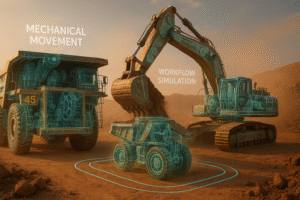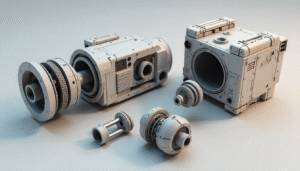The integration of 3D graphics in product marketing has become a key strategy for achieving digital success. By utilizing 3D modeling and 3D rendering technology, brands can create stunning 3D product renders that showcase the product features in a way that traditional product photography cannot. These photorealistic images and animations allow consumers to visualize products in an interactive manner, enhancing their online shopping experience. Furthermore, the power of 3D extends to creating 3D product animations that engage audiences, making them more likely to share and promote products in their own digital marketing efforts.
In the realm of e-commerce, 3D visualization plays a pivotal role in product development and marketing materials. Professional 3D rendering services help brands create detailed prototypes that can be tested and refined before launch. This not only accelerates the product design process but also provides a competitive edge in advertising. The benefits of 3D technology are clear: it allows companies to effectively showcase products and create an immersive experience that captivates potential buyers, ultimately driving sales and building brand loyalty.
Moreover, the motion inherent in 3D animations adds an extra layer of engagement, making products come alive. With interactive 3D experiences, consumers can explore every angle of a 3D model, fostering a deeper connection with the digital product. As more businesses embrace the power of 3D modeling, the future of digital marketing will undoubtedly be shaped by the innovative ways brands choose to present their offerings. In this landscape, 3D product modeling is not just a trend but a fundamental approach to staying relevant and competitive.
Understanding 3D Graphics in Marketing
Understanding 3D graphics in marketing is essential for businesses aiming to enhance their product presentation. By leveraging 3D modeling, companies can create a 3D representation of their products, showcasing detailed product features that traditional methods may overlook. 3D rendering allows for the generation of photorealistic product images, providing a 3D scene that captivates potential buyers. The benefits of 3D modeling also extend to product packaging, offering a comprehensive view that aligns with modern marketing and advertising strategies.
With the versatility of 3D technology, businesses can utilize 3D design and product rendering to achieve their marketing goals. 3D renders provide a unique opportunity to visualize products in a way that resonates with consumers. The leading 3D software enables marketers to produce single 3D images that highlight key attributes, ultimately revolutionizing the way products are showcased. As rendering is the process of creating lifelike images, it plays a crucial role in enhancing the overall customer experience.

What are 3D graphics and how do they differ from 2D graphics?
3D graphics represent a visual technology that creates three-dimensional objects through 3D modeling, allowing artists to build 3D shapes and render them in a virtual space. This differs from 2D graphics, which only depict height and width, lacking depth. 3D rendering enhances these models into lifelike images, crucial in today’s digital landscape.
The best 3D product marketing often utilizes product rendering, where 3D artists create photorealistic 3D images that showcase products from multiple angles. Comprehensive 3D marketing strategies are revolutionizing how businesses present products in their own space, making your product appealing without the need for physical samples.
With 3D modeling software, artists can create primitive 3D designs or immersive 3D environments that engage consumers. The role in modern marketing strategies cannot be overstated, as product 3D rendering provides compelling visuals that drive consumer interest and enhance brand visibility.
Why are 3D graphics becoming increasingly popular in product marketing?
3D rendering is transforming the landscape of product marketing, offering a dynamic way to showcase products. By utilizing various types of 3D graphics, brands can create immersive experiences that captivate consumers. With product rendering being the process of generating lifelike images, marketers can present 3D photorealistic visuals that highlight details and features more effectively than traditional methods.
When it comes to product marketing, this technology is revolutionizing product presentations, allowing consumers to explore products without the need for physical samples. As a result, companies can enhance engagement, drive sales, and build a stronger connection with their audience.
How do 3D graphics enhance user engagement and experience?
3D rendering significantly enhances user engagement by providing visually immersive experiences that capture attention and stimulate curiosity. The depth and realism of 3D graphics allow users to interact with content in ways that traditional 2D visuals cannot achieve, making activities more dynamic and engaging.
Furthermore, 3D rendering enables the creation of detailed environments and characters, which helps users form emotional connections with the content. This emotional engagement encourages longer interaction times and deeper exploration of the material, resulting in a more satisfying user experience.
The Benefits of Using 3D Graphics in Product Marketing
Using 3D rendering in product marketing offers numerous advantages that can significantly enhance consumer engagement. First, it allows brands to showcase their products in a visually captivating manner, providing a realistic representation that static images cannot match. This immersive experience helps potential customers better understand the product’s features and functionality. Additionally, 3D graphics can be easily adapted for various platforms, ensuring consistent branding across social media, websites, and advertisements. Ultimately, incorporating 3D rendering not only boosts aesthetic appeal but also drives higher conversion rates by fostering trust and interest among consumers.
What advantages do 3D graphics offer over traditional marketing methods?
3D graphics offer a dynamic and engaging way to present products, capturing the attention of potential customers more effectively than traditional marketing methods. They provide a sense of realism and depth, allowing consumers to visualize products in a lifelike manner. This immersive experience can lead to increased customer engagement and improved retention of information.
Additionally, 3D visuals can be easily adapted for various platforms, including websites, social media, and virtual reality environments, enhancing brand versatility. They also allow for interactive elements, enabling users to explore features and functionalities, which can drive higher conversion rates.
How can 3D visuals improve product visualization for consumers?
3D visuals significantly enhance product visualization for consumers by providing a more immersive and interactive experience. Unlike traditional images, 3D models allow users to view products from multiple angles, offering a realistic sense of depth and texture. This technology enables consumers to explore intricate details, making informed decisions before purchase. Additionally, augmented reality applications can further bridge the gap between digital and physical experiences, allowing users to visualize how products fit into their own environments. Overall, 3D visualization fosters greater engagement and confidence in consumer choices.
In what ways do 3D graphics contribute to brand storytelling?
3D graphics play a crucial role in enhancing brand storytelling by creating immersive visual experiences that captivate audiences. Through realistic models and engaging animations, brands can convey their messages more effectively, allowing consumers to connect emotionally with the narrative.
Additionally, 3D visuals enable brands to showcase their products in a dynamic way, highlighting features and benefits that might be overlooked in traditional media. This not only elevates the storytelling but also fosters a deeper understanding of the brand’s values and mission.
Moreover, the use of 3D technology can help differentiate a brand from its competitors, establishing a unique identity that resonates with consumers. As a result, the integration of 3D graphics becomes a powerful tool in modern marketing strategies.
Implementing 3D Graphics in Your Marketing Strategy
Implementing 3D graphics in your marketing strategy can significantly enhance customer engagement. By incorporating immersive visuals, brands can create a more compelling narrative that captivates their audience. This technology allows for a more interactive experience, enabling potential customers to visualize products in a realistic manner. Furthermore, 3D animations can be used in various formats, from social media ads to website designs, ensuring consistent brand messaging across platforms. Ultimately, leveraging 3D graphics not only boosts brand visibility but also fosters a deeper emotional connection with consumers.
What tools and software are available for creating 3D graphics?
There are numerous tools and software available for creating 3D graphics, catering to both beginners and professionals. Popular options include Blender, a powerful open-source software that offers a comprehensive set of features for modeling, animation, and rendering. Another widely-used tool is Autodesk Maya, known for its advanced capabilities in character animation and visual effects.
For those focusing on game development, Unity and Unreal Engine provide robust environments for integrating 3D graphics with interactive elements. Additionally, software like Cinema 4D and ZBrush specialize in motion graphics and detailed sculpting, respectively, making them invaluable assets for artists in various industries.
How can businesses effectively integrate 3D graphics into their existing marketing campaigns?
To effectively integrate 3D graphics into existing marketing campaigns, businesses should begin by identifying key touchpoints where visual storytelling can enhance their message. Utilizing 3D models in product demonstrations, for instance, can offer potential customers a more immersive experience.
Furthermore, integrating augmented reality features allows consumers to visualize products in their own environment, bridging the gap between online and offline shopping experiences.
Lastly, promoting interactive content, such as dynamic ads or engaging social media posts, can significantly boost audience engagement and brand awareness.
Case Studies: Success Stories of 3D Graphics in Product Marketing
Case studies showcasing the success of 3D graphics in product marketing reveal transformative impacts across various industries. For instance, a prominent electronics brand utilized 3D modeling to create immersive visualizations of their latest smartphone, enhancing customer engagement and boosting sales significantly. Similarly, a fashion retailer implemented 3D rendering to showcase their clothing line, allowing potential buyers to visualize products in a more interactive manner. These examples illustrate how effective 3D graphics can elevate marketing strategies, providing consumers with an enriched shopping experience that drives purchasing decisions.
What brands have successfully leveraged 3D graphics in their marketing efforts?
Nike has effectively utilized 3D graphics to create immersive experiences, allowing customers to visualize their products in a detailed and engaging manner. Their online campaigns often feature dynamic 3D models that enhance the shopping experience, making it easier for consumers to appreciate the craftsmanship of their footwear.
Similarly, Apple has incorporated 3D visuals in its product launches and advertisements, showcasing devices in a captivating way. This not only highlights the sleek design of their products but also emphasizes functionality, ensuring customers understand their value.
Lastly, Volkswagen has embraced 3D technology in its marketing to create stunning visuals of its vehicles, enhancing brand appeal and customer engagement.
What specific strategies did these brands use to achieve success?
Successful brands employ a variety of strategies to maintain their competitive edge and achieve growth. One key approach is leveraging social media marketing to engage directly with consumers, fostering a sense of community and brand loyalty. Additionally, these brands often utilize data analytics to understand consumer behavior and tailor their offerings accordingly. Furthermore, a strong emphasis on innovation allows them to adapt to changing market trends, ensuring they stay relevant. Lastly, effective collaborations with influencers and other brands can amplify their reach and enhance their credibility.
Challenges and Considerations When Using 3D Graphics
Utilizing 3D graphics presents numerous challenges that developers must navigate. One significant hurdle is the complexity of rendering, which can lead to high computational demands and slow performance, especially on less powerful hardware. Additionally, ensuring compatibility across various platforms and devices can be tricky, as different systems may interpret 3D data differently.
Another consideration is the learning curve associated with 3D modeling software, which can be daunting for beginners. Furthermore, achieving realistic lighting and texturing requires a deep understanding of artistic principles and technical skills, complicating the design process.

What common pitfalls should marketers avoid when incorporating 3D graphics?
When incorporating 3D graphics, marketers should avoid common pitfalls that can detract from their message. First, overcomplicating designs can confuse audiences; simplicity often enhances clarity. Additionally, neglecting optimization for various platforms can lead to slow load times, frustrating users. It’s also crucial to consider accessibility; ensure 3D elements are usable for individuals with disabilities. Lastly, failing to maintain brand consistency with visual elements can dilute brand identity, making it essential to align graphics with overall marketing strategies.
How can businesses overcome the technical challenges of creating high-quality 3D visuals?
To overcome the technical challenges of creating high-quality 3D visuals, businesses must invest in advanced software tools and training for their teams. Utilizing cutting-edge rendering technologies can significantly enhance visual output while ensuring efficiency. Collaboration with experienced 3D artists can also bridge the skill gap, allowing for the integration of best practices. Moreover, adopting a robust workflow pipeline helps streamline the production process, reducing setbacks. By prioritizing these strategies, companies can produce stunning visuals that captivate audiences and stand out in the competitive market.
The Future of 3D Graphics in Product Marketing
The future of 3D graphics in product marketing is poised for significant transformation, driven by advancements in technology. As virtual reality and augmented reality become more accessible, brands will leverage immersive experiences to engage consumers.
Enhanced visualization techniques will allow potential buyers to interact with products in a virtual environment, fostering a deeper understanding of features and benefits. Furthermore, the integration of AI will enable personalized marketing campaigns, tailoring 3D content to individual preferences.
Overall, the evolution of 3D graphics will not only enhance consumer engagement but also streamline decision-making, ultimately driving sales and brand loyalty.
What emerging trends in 3D graphics should marketers be aware of?
Marketers should pay close attention to the rise of real-time rendering, which allows for dynamic, interactive experiences that engage consumers more effectively. Additionally, the integration of augmented reality (AR) into marketing strategies is becoming increasingly popular, enabling customers to visualize products in their own environments before making a purchase.
Another trend is the use of 3D animations in social media content, which can capture attention and convey complex messages quickly. Lastly, the growth of virtual reality (VR) experiences can provide immersive storytelling opportunities that deepen brand connections and enhance customer loyalty.
How is technology evolving to enhance the use of 3D graphics in marketing?
Technology is rapidly evolving to enhance the use of 3D graphics in marketing, transforming how brands engage with consumers. Cutting-edge tools like augmented reality (AR) and virtual reality (VR) enable immersive experiences, allowing customers to interact with products in a virtual space.
Additionally, advancements in rendering software and graphics engines have made it easier for marketers to create stunning visuals that capture attention. These technologies not only improve the quality of 3D content but also streamline the production process, making it more accessible for businesses of all sizes.
Conclusion
3D graphics are revolutionizing digital marketing by offering more engaging, cost-effective, and scalable solutions. Businesses that adopt 3D technology gain a competitive edge by enhancing customer experiences and boosting conversions.
FAQs
Q1: How do 3D graphics improve product marketing?
3D visuals enhance engagement, reduce return rates, and offer a more immersive shopping experience.
Q2: Are 3D product visualizations better than traditional images?
Yes, they provide a more accurate representation and allow for real-time customization.
Q3: What industries benefit most from 3D marketing?
E-commerce, real estate, fashion, and consumer electronics see the most impact.
Q4: How expensive is it to implement 3D graphics in marketing?
Costs vary but are generally lower than traditional photography in the long run.
Q5: How do 3D graphics affect website SEO?
When optimized correctly, 3D content enhances engagement and improves rankings on search engines.






